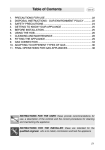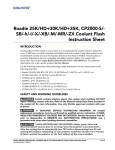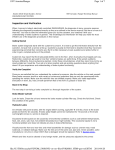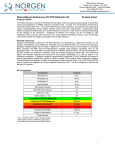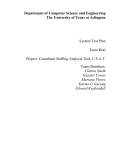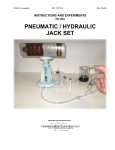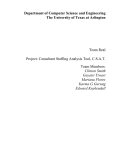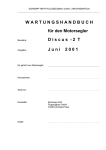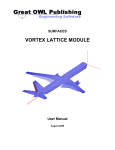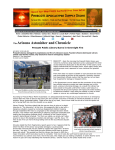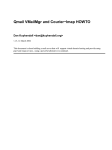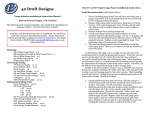Download Assembling the Elevator
Transcript
Design | Manufacture | Database | Galleries | Issues | Competitions | Projects | Files | Records | Stories | Links | Yahoo Group Assembling the Elevator Note: This page applies to early model Standard Cirrus gliders with T-fitting(1) Elevator attachment mechanisms, as pictured here. (Click the image for a larger view.) Assembly Procedure (Flight and Service Manual, pg. 19) It is advisable to mount the Elevator by one person only. Lock the trim in a front position first. Put the Elevator onto the top of the vertical tail plane with the nose about 45 degrees down. Keep it in this position, holding it with the left hand. Insert the hook of the push rod(4) between the ball bearings of fitting(3) and push it forward. Drop the trailing edge of the Elevator until the lower end of the T-fitting(1) is sitting on the locking bolt(8). Push the locking handle(9) forward, using a bar of about 8 to 10 mm, 3/8" dia. The plane drops when moving it slightly forward. Insert the two short pins on fitting(1) into their bushings on fitting(6) by rocking the plane gently back and forth. The plane drops again about 5 mm, 3/16". Pull the locking handle(9) fully back, where it is held in place by two separately acting springs. Comments It is important to follow these steps exactly if the elevator is to go on without problems. I have spent as much as half an hour in the hot sun without success, only to discover that the trim was all the way back rather than forward. If the control stick is not far enough forward, the hook will not reach high enough to properly mate with the two ball bearings. On my ship, when I retract the locking bolt(8), it remains aft, despite the springs pulling against it. So I usually retract it before setting the Elevator on the fin. In that case, the Tfitting(1) falls in place in one step, rather than first resting on the locking bolt(8) and then falling in place when the locking bolt(8) is retracted. Caution! Your life depends on getting this right! You can easily secure the T-fitting(1) without engaging the ball bearings. This is extremely dangerous! A Standard Cirrus pilot was killed on August 10, 2002 for this very reason. See the NTSB report. Checks Every owner of a Standard Cirrus occasionally assembles the Elevator incorrectly. They know from experience what to look for. It is very easy to spot the error. They never attach the Elevator without immediately checking their work. The risk is for new owners, who have never seen it done incorrectly and indeed may assume that if it went together, it must be right. If they are not careful, they will accept any response of the Elevator to the control stick as evidence that they got it right. Always perform the following checks to ensure proper assembly: • • • • • Use the inspection hole (window) in the elevator to verify that the hook properly mates with the ball bearings. Swing the Elevator through its full range of motion. It should move smoothly, without rattling or the sound of the hook rubbing inside the faring. Move the control stick fore and aft, from stop to stop. Do this slowly and rapidly while watching the elevator. The elevator should follow every movement of the control stick smoothly and exactly. It should be evident that the control linkage is both pushing and pulling the elevator. Notice the angle of the Elevator with the control stick fully aft. The fairing should be fully concealed within the vertical fin. If the hook is not properly mated with the ball bearings the leading edge of the Elevator will not dip far enough. Perform a positive control check! This will confirm that the hook is both pushing and pulling the nose of the Elevator. A Look Inside (Stefan Melber) Access Holes Spar Connection T-Fitting A Message from Tom Knauff (26 Aug 2002) Yesterday, we intentionally incorrectly installed the Elevator on a Std Cirrus. It's not too difficult to do, however, once installed, it is very obvious it is not correct. When the control stick is moved back and forth, the push rod makes a lot of noise as it bangs around inside the Elevator. There is no movement up. The fairing on the bottom, leading edge of the Elevator is well above the normal position so you can see the bottom of the fairing. Doing a positive control check, if you hold the Elevator in one position, the control stick can feel as though it is connected when you pull or push, however, there is a lot of slop when you switch from pull to push. A slight jiggle cases the elevator push rod to make a lot of noise. If your clear vision disc is no longer clear so you can see to inspect the connection, consider removing the disc and taping over the hole until you replace the disc. After installing the Elevator correctly, consider painting two thin lines on the rudder to show the normal travel limits of the elevator. This may become an FAA recommendation as well. Thomas Knauff Worst Case Scenario This scenario is offered to help you recognize your error quickly in the unlikely event that you improperly attach the Elevator and then fail to perform the required checks. Disclaimer: I must plead ignorance of the geometric relationship between the Elevator pivot and the center of lift, as well as the aerodynamics needed for a proper analysis. So, the following analysis may be flawed. But I am confident that you will agree with the main points. The Problem: The T-fitting(1) is secured by the locking bolt(8), but the hook does not engage the lower bearing. So the hook is free to move about laterally. The lower bearing rests on top of the hook pushing it against the forward edge of the bearing access slot, and the front of the Elevator is abnormally high. Perhaps the hook engaged the edge of the access slot, so that there is some control in both directions. The front edge of the access slot is not strong stuff, and the fiberglass will break when aerodynamic forces on the Elevator jam the hook between it and the bearings. Correc t and Incorrect Assembly Click for larger image. Drawing by Bob Kuykendall. With the control stick fully forward, the front of the Elevator will be forced up; however, if the access slot is not hung up on the hook, it is free to go still higher since the stop is located at the control stick, not in the Elevator. On the other hand, with the stick fully aft, the hook will be at its lowest position and the Elevator, if the edge of the access slot is not hooked, will be free to swing down as far as the hook allows. If the glider is in motion, you can expect the Elevator to flip from one limit or the other. Either the leading edge will be up (pitching the glider down), or it will be down (either pitching the glider up or reducing the downward pitching, to some degree, depending on the position of the stick and the damage to the bearing access slot). This is not a pretty picture! The Ground Roll: For a normal launch, the trim will be in a forward position, anticipating the airspeed on tow. The stick will be somewhat forward or will be moved forward, as airspeed builds, to lift the tail, giving the ship a proper attitude for a gentle lift off. This action forces the front of the Elevator high, although it is free to move yet higher. So, the tail will lift off as expected, but you may be surprised that it stays high even though you have pulled the stick back to a center position. When the tail stays up, you continue to pull the stick aft. ... Airspeed is building as are forces acting on the Elevator. The Decision Point: You're getting concerned (or annoyed) because you have enough airspeed to lift off, but the tail is too high still and it isn't responding even with the stick farther aft than necessary. Perhaps the tow plane has lifted off and you're still on the ground. At this point you are well behind the curve! Already, you should have seen the signs, pulled the release, pulled the airbrakes, and squeezed the wheel brake for all it's worth! But, you're not inclined to panic, nothing bad is happening and instinct urges you to pull the stick all the way...and you do. Now the push rod(4) is fully down and the Elevator has maximum freedom. The Launch: Now the tail wheel runs over a bump, and the Elevator decides to swing the other way, all the way the other way! The leading edge flips down as far as the stick allows, considering the rigging error. And with all that airspeed, the glider shoots up into the sky. Now you panic! Now you shove the stick all the way forward, forcing the front of the elevator up. If you were quick enough, the glider heels over, and you pull back on the stick to control your rate of descent. But the elevator stays up and the glider noses down too steeply. If you're lucky, on the way down, the elevator decides to flip, leading-edge down, and recovers from the dive. By then, however, you've pulled the stick all the way back again, so the the Elevator swings too far and you go shooting up into the sky again. ... You get the idea. In all the panic, you completely forget to pull the release. The Crash: On the first or second up swing (if you get that far) the rope breaks because it has a proper weak link. Perhaps this saves the tow pilot and tug, since he didn't have time to pull his release because everything happened so quickly. Now the glider has an extremely nose high attitude and you are forcing it down with full forward stick, shoving the front of the Elevator up. It may heel over, or it stall and fall nose down, or it may tail slide. Most likely you will hit the ground at a very steep nose-down attitude, perhaps past vertical. ... The rest you can imagine. The Moral: • • • • Love your wife! Install the Elevator correctly! Perform the assembly checks and a positive control check! Release at the very first sign of something unexpected! Don't think! Don't wait for trouble! Just release! Conclusions • • • The Standard Cirrus is a good bird. Nearly seven hundred have been flying for over thirty years with an excellent safety record. Even modern gliders sometimes launch with improperly attached tail assemblies. The Standard Cirrus is no worse than others in this regard. The elevator is the most critical control on your aircraft. Get it wrong and your chance of survival after lift off is nil. Jim Hendrix Balancing the Elevator Pages 28 and 29 of the Flight and Service Manual give specifications for weight and balance of control surfaces. The manual specifies a maximum weight for the elevator of 7.1 kg (15.65 lb). The maximum hinge moment is 0.143 m*kg (1.03 ft*lb). Weighing the elevator is easy. The maximum weight includes the T-fitting, so you can merely place the whole assembly on a scale an take the reading. The T-fitting design makes balancing this elevator easy too. All you need to do is fix the stem of the T-fitting in a vice to hold the elevator horizontal, with complete freedom of movement. Take care not to over tighten the vice with consequent damage to the T-fitting. Cloth cushioning in the vice jaws is a good idea. Mount the elevator so that it's aft edge is over a work surface where you can place a small, accurate scale, like a postage scale. For better accuracy, use a scale with the smallest range possible. Zero the scale, then stand a stick or rod on the scale and rest the rear edge of the elevator on it. The length of the stick should be such that the elevator chord is horizontal. Read the weight and subtract the weight of the stick. For the hinge moment, multiply this weight times the moment arm, the distance from the hinge axis to the support point where the elevator rests on the stick. For better accuracy, the stick may have a pointed end or the elevator may be supported at it's trailing edge. To measure the moment arm, you need to find the hinge axis. Since the hinge bearings are buried within the elevator this is difficult to do. However, Stefan Melber opened up his elevator and removed the T-fitting, bearings and brackets. He has measured the distance from the elevator hinge axis to the center of the two locator pins on the T-fitting. This distance is 27.6 mm (1.087"). So, to get the moment arm, you can measure from the aft support point to the center of the locator pins on the T-fitting and add 27.6 mm. The longer the moment arm, the better the accuracy. This is because the down force on the scale will be less and you can use a more sensitive scale, also, the error in your measurement of the moment arm will be less significant if the moment arm is longer. One way to lengthen the moment arm is to tape a beam in the chordwise direction to the elevator so that it extends aft to say two or three times the normal moment arm. The weight of the beam will not affect the result if it is balanced over the hinge axis, so you should let it extend forward just as far as it extends aft of the hinge axis. Furthermore, if the beam is light weight, errors in placement will be reduced. A balsa wood beam from a hobby shop is ideal. Equally space the mounting tape on both sides of the pivot axis to eliminate the weight of the tape. Don't be surprised if you find your elevator too tail heavy. I am aware of two ships where, for no apparent reason, this was the case. I suspect that the current balance specification might have been tightened up after earlier ships were built. In any case, the important thing is to get the elevator within specifications by adding lead to the nose. This is necessary to control the possible onset of flutter at speeds below Vne. Before adding weight to the nose of the elevator, investigate the possibility that you have foreign matter inside the elevator. Perhaps Dirt Daubers have built nests inside. It's impossible to know for sure without cutting inspection holes and looking inside. Short of that, you could pound on the surfaces with your hand to flex the skin causing the dirt nests to break loose and rattle around inside. Flushing with water might also loosen them. If you do have foreign matter inside, it seems likely that it would not be equally distributed spanwise through the elevator. So, hang the elevator from the hole at the tip of the T-fitting and see if it hangs level, indicating that the left and right sides weigh the same. Tapping on the surfaces of the elevator can also be used to give audible indications of unusual mass loading on the inside of the skins. I went through this exercise with #60 but stopped short of cutting inspection holes. In the end, I was convinced that the elevator simply came from the factory too heavy at the rear according to current specifications. Very likely, the amount of weight needed to bring the hinge moment into specification, will take the elevator over the maximum gross weight. In that case, contact Schempp-Hirth and they will approve the modification. They will tell you that the important thing is reducing the hinge moment. If the elevator must go over gross to do that, then it must be done. After adding ballast to the nose of the elevator, you will need to correct the effect on the glider's CG by adding ballast to the nose of the glider. Also, you will need to adjust the trim spring tensions.






